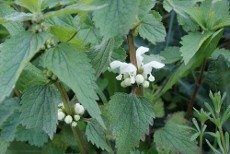How To Create A Moon Garden
Lee Miller is a professional landscape designer, garden blogger and author involved in the horticultural industry since 1996. Having started a gardening blog in 2010, she has written over 250 articles on general gardening, landscape design principles, gardening tips, planting, pruning, garden maintenance, feature plants and more. In addition, Lee Miller is the author of two books, A Guide to Northeastern Gardening, published in 2015 and Landscape Design Combinations, published in 2017. Lee enjoys sharing her experience with others and with trowel in hand since the age of five, her passion for gardening continues to grow.
Throughout history, the color white has been known to emanate a sense of peace, romance and elegance, and is considered neutral in the garden. White blooms and foliage offer contrast in the daytime garden and make other colors "pop", but as darkness approaches they take on yet another role. Plants with white blooms or silvery-white foliage tend to become more prominent during the early dawn and evening hours and have become quite popular in the design of moon, or night gardens. Moon gardens are designed with plants whose foliage and blooms cause them to stand out at night and are planned to portray a peaceful sanctuary. Many night-blooming plants, such as Moonflower (Ipomoea alba) have blooms that are white and extremely fragrant, while some blooms, such as petunia, release their fragrance at night. When using foliage plants such as such as Stachys (Lamb's Ear), Dusty Miller or Artemisia in a moon garden, their silvery-white leaves appear to "glow" in the moonlight. When planning your moon garden, position it in a place where it can be accessed and appreciated, such as near a patio, sitting area or walkway. Subtle landscape lighting can also be added to enhance and highlight the white blooms and add greater brightness to your space. Hardscape elements can also be added to highlight your moon garden. This rounded structure is known as a moon gate, named for its shape, and would look lovely as an entrance to your night time garden. A white gravel path, bench, pergola or garden statue can also enhance your space for viewing in darkness and a water feature may be added to create a soothing background sound. When it comes to selecting plants, Spring blooming flowers with white blooms include Allium 'Mount Everest', Crocus, Lilly of the Valley, Hyacinth, Tulip, Candytuft and Snowdrops. Summer blooming white blooms include Cerastium tomentosum (Snow in Summer), Astilbe 'Visions White', Aruncus (Goat's Beard) and Oriental Lily 'Cassablanca'. Late summer blooms include Dahlia, Montauk Daisy, Echinacea 'White Swan', Phlox and Clematis 'Sweet Autumn'. Shrubs with beautiful white blooms include Azalea 'Autumn Angel', Rhododendron 'Catawba' or 'Chionoides', Hydrangea 'Pee Gee', 'Limelight', 'Annabelle' and 'Blushing Bride', Viburnum 'Summer Snowflake' and Butterfly Bush 'White Profusion'. For silvery-white to white foliage try Dusty Miller, Lamb's Ear, Artemeisia or variegated plants such as 'Patriot' Hosta, with green and white variegated leaves.
Moon gardens have been around for centuries but have become increasingly popular over the years as lifestyles become more complex and homeowners seek a peaceful retreat after a stressful day at work. For all-season interest, add evergreens displaying deep green foliage such as boxwood, holly or yew to create a structural backdrop along with the white blooming plants of your choosing. Also recommend is to mass the same species of plant together to create maximum impact and to plant in odd numbers for a more natural look. Any combination of plants and hardscape with the characteristics discussed can be used to help plan your nighttime moon garden, one that will make a lovely and peaceful addition to your landscape!
Gardening tips, videos, info and more delivered right to your inbox!
Sign up for the Gardening Know How newsletter today and receive a free download of our most popular eBook "How to Grow Delicious Tomatoes."
-
 Want a Backyard Mini Orchard? Create Your Own Container Orchard
Want a Backyard Mini Orchard? Create Your Own Container OrchardEasier to care for in small spaces, a backyard mini-orchard makes sense for busy gardeners and juicy fruit is the reward.
By Teo Spengler
-
 Urban Beekeeping Guide: Top Tips For Raising Bees In The City
Urban Beekeeping Guide: Top Tips For Raising Bees In The CityUrban beekeeping can be a rewarding and appreciated pastime, but first be sure it’s legal in your city and learn the ropes of beekeeping.
By Mary Ellen Ellis
